DATA4000 Business Data Analytics: Case Study Analysis and Solutions
VerifiedAdded on 2022/09/22
|7
|2343
|16
Case Study
AI Summary
This document provides a comprehensive analysis of a business data analytics case study. It examines the application of analytics in the art and architecture industry, focusing on recreating artistic works using big data and machine learning, as well as the Amsterdam Fire Department, where linked data analytics is used to address fire outbreaks. The analysis includes descriptions of the industries, business problems, analytics types, challenges, and recommendations. The case study further explores the roles of descriptive and predictive analytics in solving business problems, particularly in the context of customer feedback. Finally, the document discusses the roles of various analytics professionals, including data visualization analysts, business analysts, data scientists, and analytics translators, highlighting the most suitable forms of analytics for each role and providing recommendations for their application.
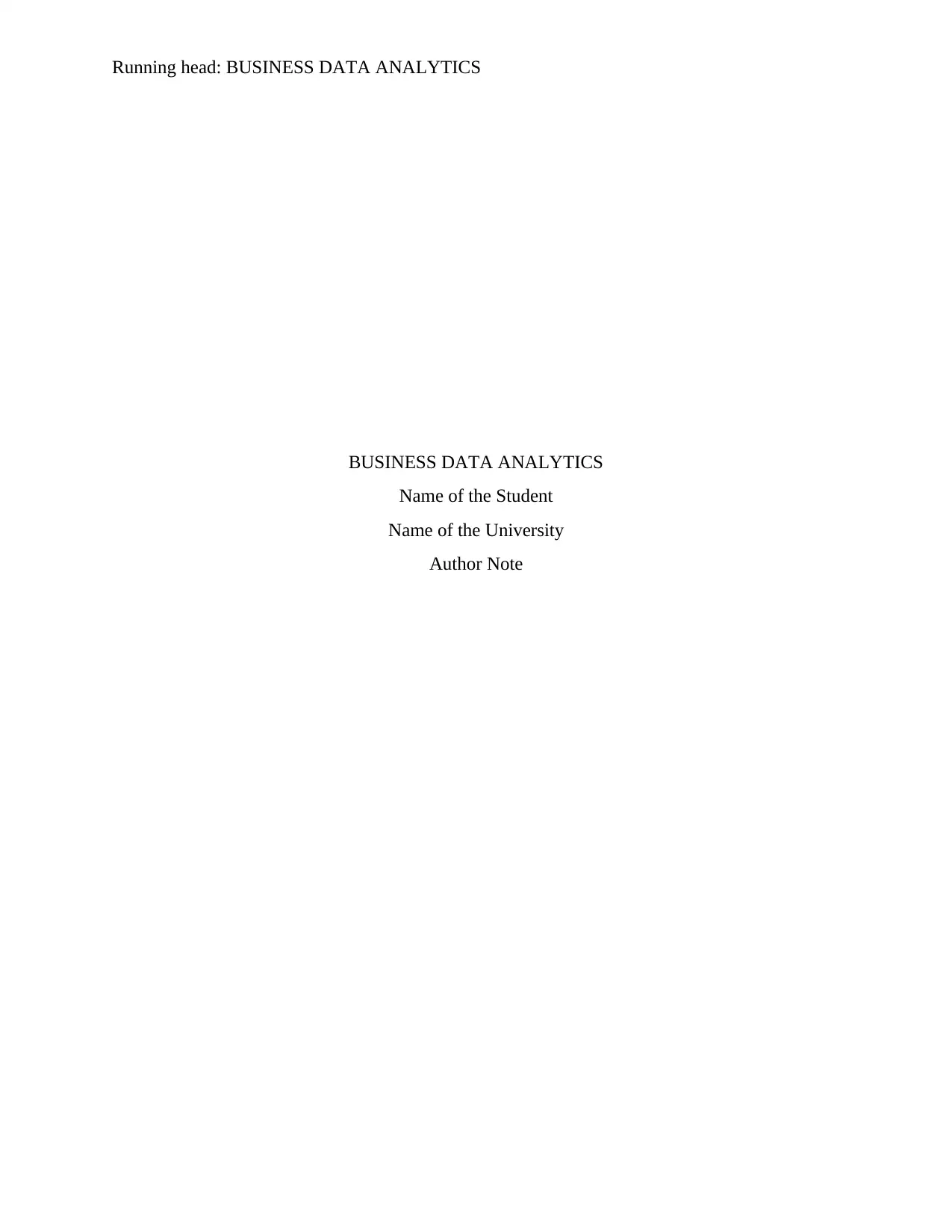
Running head: BUSINESS DATA ANALYTICS
BUSINESS DATA ANALYTICS
Name of the Student
Name of the University
Author Note
BUSINESS DATA ANALYTICS
Name of the Student
Name of the University
Author Note
Paraphrase This Document
Need a fresh take? Get an instant paraphrase of this document with our AI Paraphraser
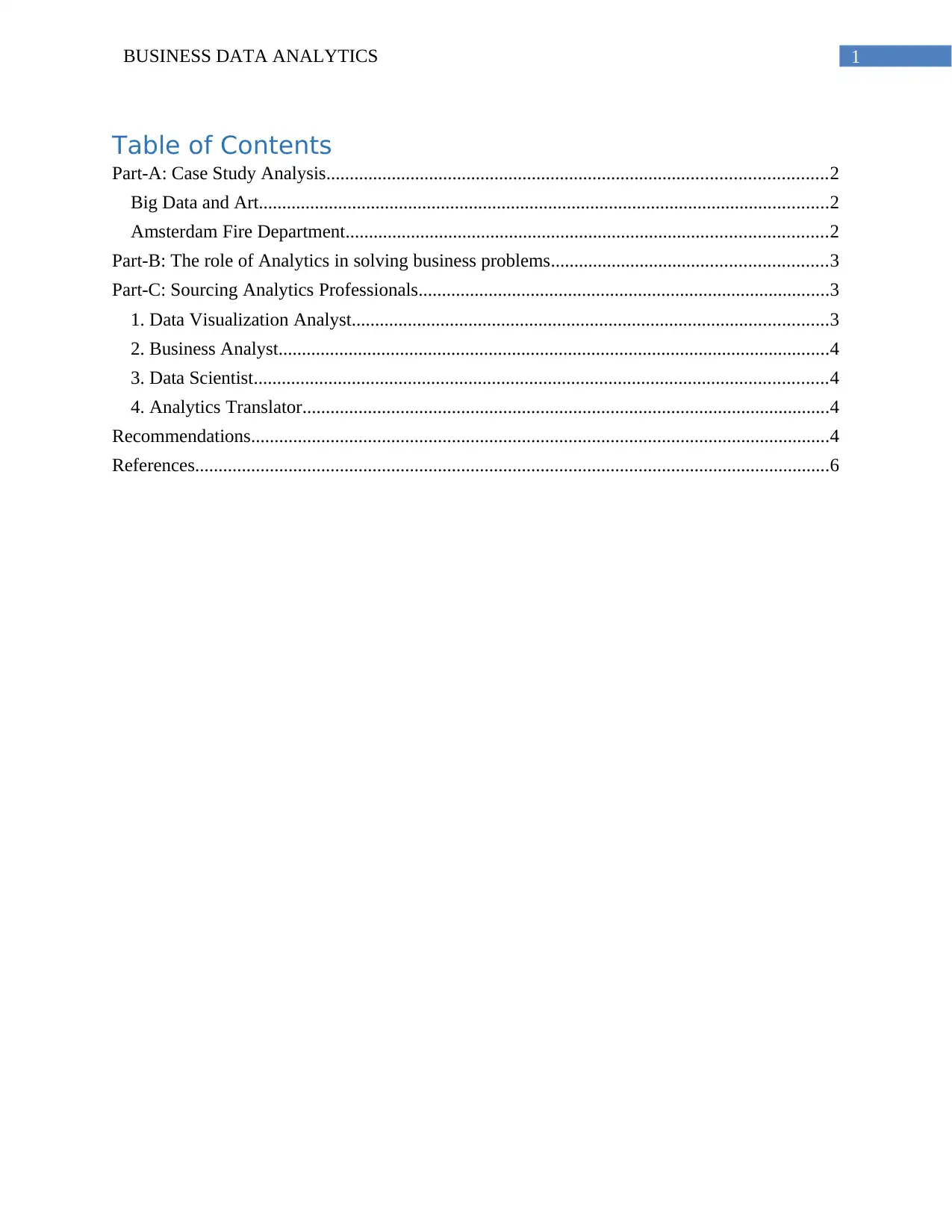
1BUSINESS DATA ANALYTICS
Table of Contents
Part-A: Case Study Analysis...........................................................................................................2
Big Data and Art..........................................................................................................................2
Amsterdam Fire Department.......................................................................................................2
Part-B: The role of Analytics in solving business problems...........................................................3
Part-C: Sourcing Analytics Professionals........................................................................................3
1. Data Visualization Analyst......................................................................................................3
2. Business Analyst......................................................................................................................4
3. Data Scientist...........................................................................................................................4
4. Analytics Translator.................................................................................................................4
Recommendations............................................................................................................................4
References........................................................................................................................................6
Table of Contents
Part-A: Case Study Analysis...........................................................................................................2
Big Data and Art..........................................................................................................................2
Amsterdam Fire Department.......................................................................................................2
Part-B: The role of Analytics in solving business problems...........................................................3
Part-C: Sourcing Analytics Professionals........................................................................................3
1. Data Visualization Analyst......................................................................................................3
2. Business Analyst......................................................................................................................4
3. Data Scientist...........................................................................................................................4
4. Analytics Translator.................................................................................................................4
Recommendations............................................................................................................................4
References........................................................................................................................................6

2BUSINESS DATA ANALYTICS
Part-A: Case Study Analysis
Big Data and Art
The industry to which the analytics have been applied is art and architecture. The
industry is associated with recapturing the artworks of the greats and create the same effects. The
business problem to be solved in the case study is to recreate the works of the great Catalan
architect Gaudi and his works (Big Data and Art 2020). The idea is to create new artistic works
by studying and applying the same techniques used by the original artist, in this case Gaudi. The
type of analytics used was big data analytics. This was important as data needed to be gathered
about the original architect’s work. The original works of Gaudi was fed into the big data system,
which is called Watson and designed by IBM. The original works as well as the themes that
inspired the great architect Gaudi are fed into the system. These include documents, song lyrics
or even historical articles. The machine learning software then uses these aspects to study the
various works of the artist and use it to create a knowledge base. Subsequently, the AI system is
able to identify various relate themes, objects and ideas that can inspire the new age artists to
create art or architecture that is inspired heavily from the works of Gaudi. This helps to recreate
the beautiful imageries that were created by the actual person. There are some significant
challenges that are related to the usage of this system. Firstly, the artificial system has still some
time left before it can completely be aligned with human creativity. Secondly, the system can
falter at times as it is very difficult to capture the original inspirations of Gaudi. Thirdly, it can
limit the creative scope of the artists if not used judiciously. Some recommendations can be
provided to the artists in relation to the usage of the analytics. The artist need to use it as a source
of inspiration and not use it to plagiarize. Moreover, the artists have to collaborate together to
make the system even more effective. The creative scope of the artists should always be utilized
to its fullest.
Amsterdam Fire Department
The data analytics is being applied to the Fire Fighting Department of the city of
Amsterdam. The business problem is the frequent fire outbreaks in the city that happen due to
various forms of negligence or other significant causes. The fire department is focused on
finding the major factors that lead to the fire outbreaks at the various parts of the city. The type
of analytics used is linked data analytics. Firstly, the fire engines and the fire extinguishing
devices are fitted with data collection devices. These devices help gather data about the fire
incidences that the department has to control. The idea is to collect as much data as possible
through these data collection devices. Secondly, these data are used to create a special fire
fighting database. The databases are then provided to the public to view in readable form to
create more awareness.These data bases are used to create a special fire fighting online library
known as the Firebrary. The library would not only consist of the data in a readable form but at
the same time it would consist of the various firefighting terms (Amsterdam Fire Department:
The use of Big Data analytics in fighting fires 2020). The departments can learn more about
these terms to ensure that there is better knowledge sharing and management. Thirdly, the data
can be used to create predictive models that can help to find the issues that can lead to fire
incidents around the city. Some of the main challenges that are facing this type of analytics are
proper integration of the technology and the fitting the data collection devices into the fire
engines to collect more information. The challenge is that the database and predictive modelling
Part-A: Case Study Analysis
Big Data and Art
The industry to which the analytics have been applied is art and architecture. The
industry is associated with recapturing the artworks of the greats and create the same effects. The
business problem to be solved in the case study is to recreate the works of the great Catalan
architect Gaudi and his works (Big Data and Art 2020). The idea is to create new artistic works
by studying and applying the same techniques used by the original artist, in this case Gaudi. The
type of analytics used was big data analytics. This was important as data needed to be gathered
about the original architect’s work. The original works of Gaudi was fed into the big data system,
which is called Watson and designed by IBM. The original works as well as the themes that
inspired the great architect Gaudi are fed into the system. These include documents, song lyrics
or even historical articles. The machine learning software then uses these aspects to study the
various works of the artist and use it to create a knowledge base. Subsequently, the AI system is
able to identify various relate themes, objects and ideas that can inspire the new age artists to
create art or architecture that is inspired heavily from the works of Gaudi. This helps to recreate
the beautiful imageries that were created by the actual person. There are some significant
challenges that are related to the usage of this system. Firstly, the artificial system has still some
time left before it can completely be aligned with human creativity. Secondly, the system can
falter at times as it is very difficult to capture the original inspirations of Gaudi. Thirdly, it can
limit the creative scope of the artists if not used judiciously. Some recommendations can be
provided to the artists in relation to the usage of the analytics. The artist need to use it as a source
of inspiration and not use it to plagiarize. Moreover, the artists have to collaborate together to
make the system even more effective. The creative scope of the artists should always be utilized
to its fullest.
Amsterdam Fire Department
The data analytics is being applied to the Fire Fighting Department of the city of
Amsterdam. The business problem is the frequent fire outbreaks in the city that happen due to
various forms of negligence or other significant causes. The fire department is focused on
finding the major factors that lead to the fire outbreaks at the various parts of the city. The type
of analytics used is linked data analytics. Firstly, the fire engines and the fire extinguishing
devices are fitted with data collection devices. These devices help gather data about the fire
incidences that the department has to control. The idea is to collect as much data as possible
through these data collection devices. Secondly, these data are used to create a special fire
fighting database. The databases are then provided to the public to view in readable form to
create more awareness.These data bases are used to create a special fire fighting online library
known as the Firebrary. The library would not only consist of the data in a readable form but at
the same time it would consist of the various firefighting terms (Amsterdam Fire Department:
The use of Big Data analytics in fighting fires 2020). The departments can learn more about
these terms to ensure that there is better knowledge sharing and management. Thirdly, the data
can be used to create predictive models that can help to find the issues that can lead to fire
incidents around the city. Some of the main challenges that are facing this type of analytics are
proper integration of the technology and the fitting the data collection devices into the fire
engines to collect more information. The challenge is that the database and predictive modelling
⊘ This is a preview!⊘
Do you want full access?
Subscribe today to unlock all pages.

Trusted by 1+ million students worldwide
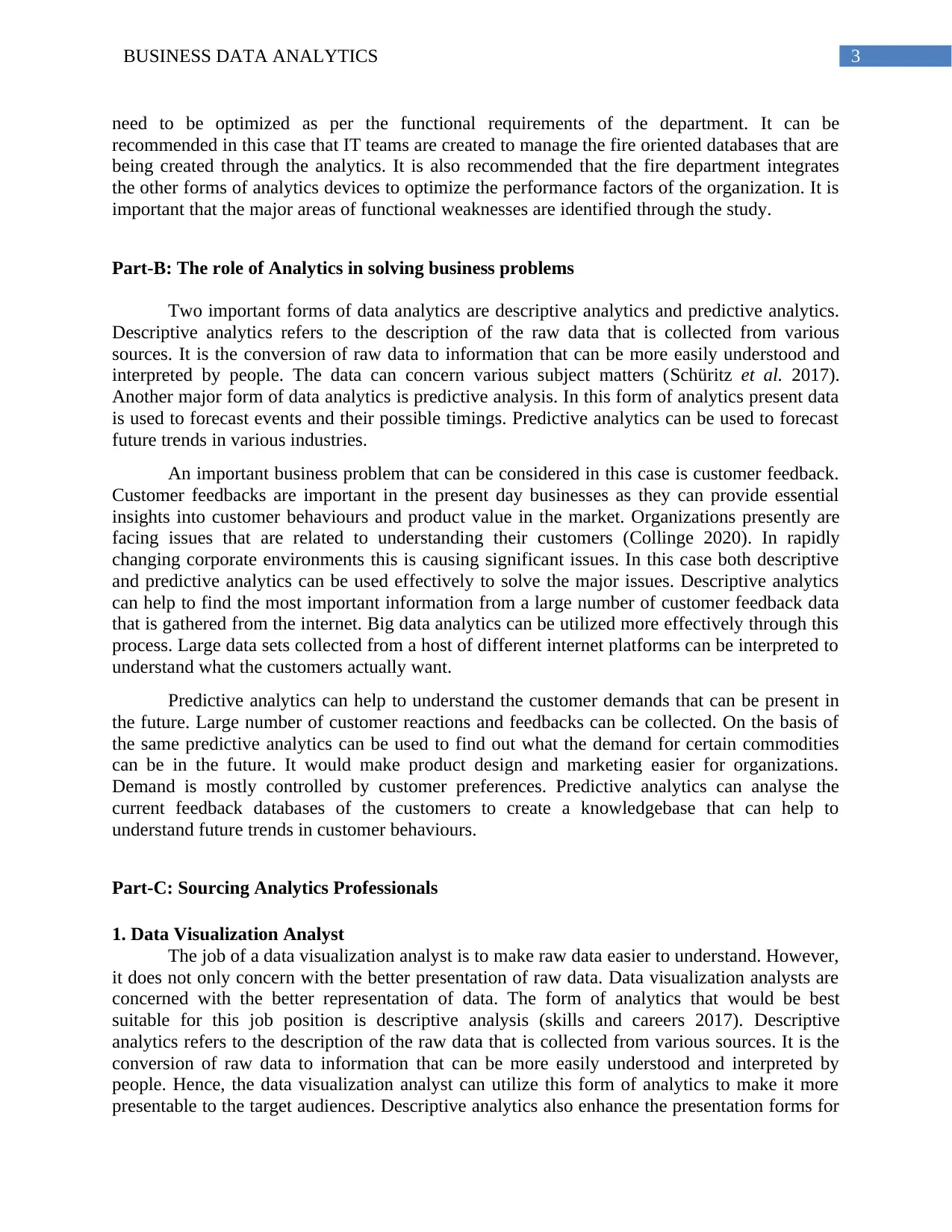
3BUSINESS DATA ANALYTICS
need to be optimized as per the functional requirements of the department. It can be
recommended in this case that IT teams are created to manage the fire oriented databases that are
being created through the analytics. It is also recommended that the fire department integrates
the other forms of analytics devices to optimize the performance factors of the organization. It is
important that the major areas of functional weaknesses are identified through the study.
Part-B: The role of Analytics in solving business problems
Two important forms of data analytics are descriptive analytics and predictive analytics.
Descriptive analytics refers to the description of the raw data that is collected from various
sources. It is the conversion of raw data to information that can be more easily understood and
interpreted by people. The data can concern various subject matters (Schüritz et al. 2017).
Another major form of data analytics is predictive analysis. In this form of analytics present data
is used to forecast events and their possible timings. Predictive analytics can be used to forecast
future trends in various industries.
An important business problem that can be considered in this case is customer feedback.
Customer feedbacks are important in the present day businesses as they can provide essential
insights into customer behaviours and product value in the market. Organizations presently are
facing issues that are related to understanding their customers (Collinge 2020). In rapidly
changing corporate environments this is causing significant issues. In this case both descriptive
and predictive analytics can be used effectively to solve the major issues. Descriptive analytics
can help to find the most important information from a large number of customer feedback data
that is gathered from the internet. Big data analytics can be utilized more effectively through this
process. Large data sets collected from a host of different internet platforms can be interpreted to
understand what the customers actually want.
Predictive analytics can help to understand the customer demands that can be present in
the future. Large number of customer reactions and feedbacks can be collected. On the basis of
the same predictive analytics can be used to find out what the demand for certain commodities
can be in the future. It would make product design and marketing easier for organizations.
Demand is mostly controlled by customer preferences. Predictive analytics can analyse the
current feedback databases of the customers to create a knowledgebase that can help to
understand future trends in customer behaviours.
Part-C: Sourcing Analytics Professionals
1. Data Visualization Analyst
The job of a data visualization analyst is to make raw data easier to understand. However,
it does not only concern with the better presentation of raw data. Data visualization analysts are
concerned with the better representation of data. The form of analytics that would be best
suitable for this job position is descriptive analysis (skills and careers 2017). Descriptive
analytics refers to the description of the raw data that is collected from various sources. It is the
conversion of raw data to information that can be more easily understood and interpreted by
people. Hence, the data visualization analyst can utilize this form of analytics to make it more
presentable to the target audiences. Descriptive analytics also enhance the presentation forms for
need to be optimized as per the functional requirements of the department. It can be
recommended in this case that IT teams are created to manage the fire oriented databases that are
being created through the analytics. It is also recommended that the fire department integrates
the other forms of analytics devices to optimize the performance factors of the organization. It is
important that the major areas of functional weaknesses are identified through the study.
Part-B: The role of Analytics in solving business problems
Two important forms of data analytics are descriptive analytics and predictive analytics.
Descriptive analytics refers to the description of the raw data that is collected from various
sources. It is the conversion of raw data to information that can be more easily understood and
interpreted by people. The data can concern various subject matters (Schüritz et al. 2017).
Another major form of data analytics is predictive analysis. In this form of analytics present data
is used to forecast events and their possible timings. Predictive analytics can be used to forecast
future trends in various industries.
An important business problem that can be considered in this case is customer feedback.
Customer feedbacks are important in the present day businesses as they can provide essential
insights into customer behaviours and product value in the market. Organizations presently are
facing issues that are related to understanding their customers (Collinge 2020). In rapidly
changing corporate environments this is causing significant issues. In this case both descriptive
and predictive analytics can be used effectively to solve the major issues. Descriptive analytics
can help to find the most important information from a large number of customer feedback data
that is gathered from the internet. Big data analytics can be utilized more effectively through this
process. Large data sets collected from a host of different internet platforms can be interpreted to
understand what the customers actually want.
Predictive analytics can help to understand the customer demands that can be present in
the future. Large number of customer reactions and feedbacks can be collected. On the basis of
the same predictive analytics can be used to find out what the demand for certain commodities
can be in the future. It would make product design and marketing easier for organizations.
Demand is mostly controlled by customer preferences. Predictive analytics can analyse the
current feedback databases of the customers to create a knowledgebase that can help to
understand future trends in customer behaviours.
Part-C: Sourcing Analytics Professionals
1. Data Visualization Analyst
The job of a data visualization analyst is to make raw data easier to understand. However,
it does not only concern with the better presentation of raw data. Data visualization analysts are
concerned with the better representation of data. The form of analytics that would be best
suitable for this job position is descriptive analysis (skills and careers 2017). Descriptive
analytics refers to the description of the raw data that is collected from various sources. It is the
conversion of raw data to information that can be more easily understood and interpreted by
people. Hence, the data visualization analyst can utilize this form of analytics to make it more
presentable to the target audiences. Descriptive analytics also enhance the presentation forms for
Paraphrase This Document
Need a fresh take? Get an instant paraphrase of this document with our AI Paraphraser
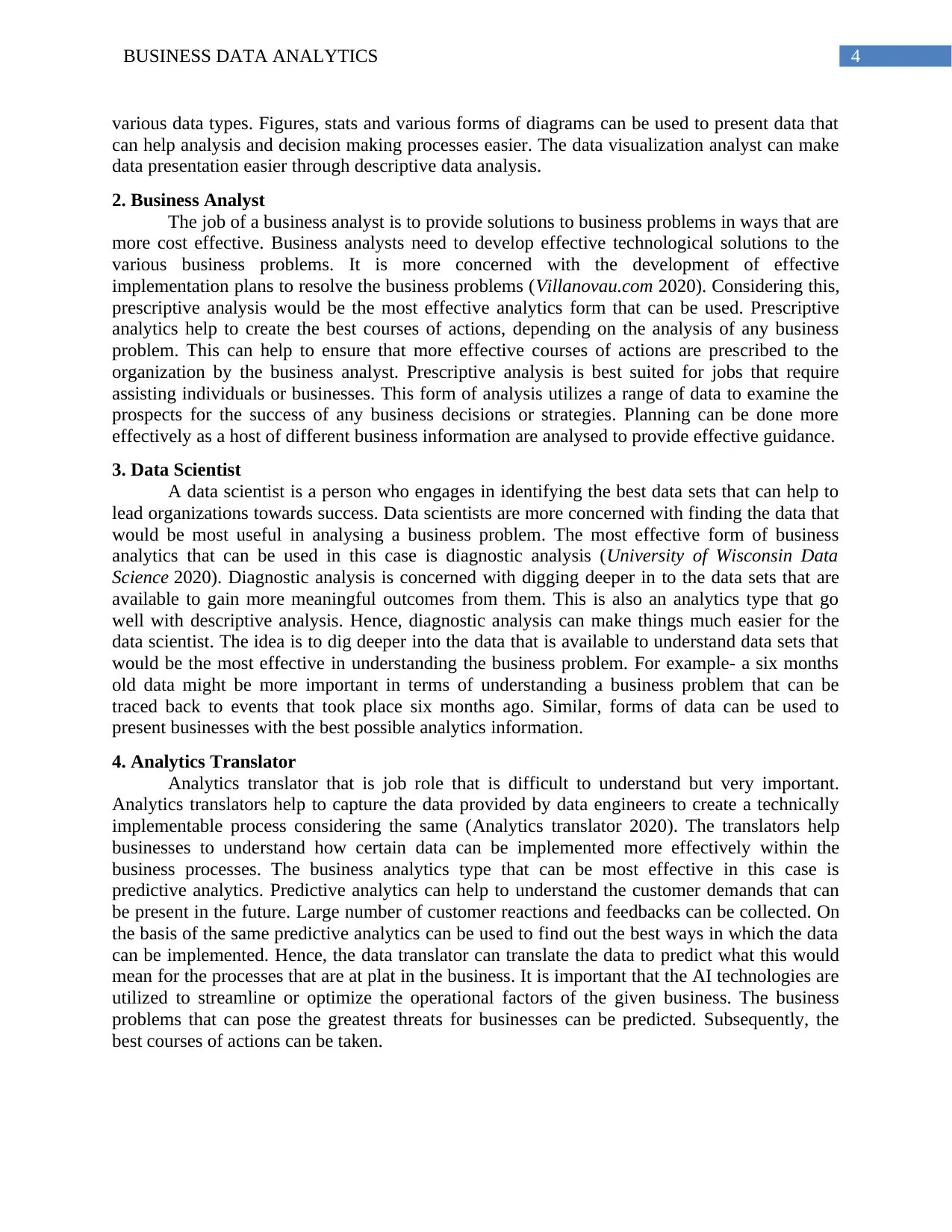
4BUSINESS DATA ANALYTICS
various data types. Figures, stats and various forms of diagrams can be used to present data that
can help analysis and decision making processes easier. The data visualization analyst can make
data presentation easier through descriptive data analysis.
2. Business Analyst
The job of a business analyst is to provide solutions to business problems in ways that are
more cost effective. Business analysts need to develop effective technological solutions to the
various business problems. It is more concerned with the development of effective
implementation plans to resolve the business problems (Villanovau.com 2020). Considering this,
prescriptive analysis would be the most effective analytics form that can be used. Prescriptive
analytics help to create the best courses of actions, depending on the analysis of any business
problem. This can help to ensure that more effective courses of actions are prescribed to the
organization by the business analyst. Prescriptive analysis is best suited for jobs that require
assisting individuals or businesses. This form of analysis utilizes a range of data to examine the
prospects for the success of any business decisions or strategies. Planning can be done more
effectively as a host of different business information are analysed to provide effective guidance.
3. Data Scientist
A data scientist is a person who engages in identifying the best data sets that can help to
lead organizations towards success. Data scientists are more concerned with finding the data that
would be most useful in analysing a business problem. The most effective form of business
analytics that can be used in this case is diagnostic analysis (University of Wisconsin Data
Science 2020). Diagnostic analysis is concerned with digging deeper in to the data sets that are
available to gain more meaningful outcomes from them. This is also an analytics type that go
well with descriptive analysis. Hence, diagnostic analysis can make things much easier for the
data scientist. The idea is to dig deeper into the data that is available to understand data sets that
would be the most effective in understanding the business problem. For example- a six months
old data might be more important in terms of understanding a business problem that can be
traced back to events that took place six months ago. Similar, forms of data can be used to
present businesses with the best possible analytics information.
4. Analytics Translator
Analytics translator that is job role that is difficult to understand but very important.
Analytics translators help to capture the data provided by data engineers to create a technically
implementable process considering the same (Analytics translator 2020). The translators help
businesses to understand how certain data can be implemented more effectively within the
business processes. The business analytics type that can be most effective in this case is
predictive analytics. Predictive analytics can help to understand the customer demands that can
be present in the future. Large number of customer reactions and feedbacks can be collected. On
the basis of the same predictive analytics can be used to find out the best ways in which the data
can be implemented. Hence, the data translator can translate the data to predict what this would
mean for the processes that are at plat in the business. It is important that the AI technologies are
utilized to streamline or optimize the operational factors of the given business. The business
problems that can pose the greatest threats for businesses can be predicted. Subsequently, the
best courses of actions can be taken.
various data types. Figures, stats and various forms of diagrams can be used to present data that
can help analysis and decision making processes easier. The data visualization analyst can make
data presentation easier through descriptive data analysis.
2. Business Analyst
The job of a business analyst is to provide solutions to business problems in ways that are
more cost effective. Business analysts need to develop effective technological solutions to the
various business problems. It is more concerned with the development of effective
implementation plans to resolve the business problems (Villanovau.com 2020). Considering this,
prescriptive analysis would be the most effective analytics form that can be used. Prescriptive
analytics help to create the best courses of actions, depending on the analysis of any business
problem. This can help to ensure that more effective courses of actions are prescribed to the
organization by the business analyst. Prescriptive analysis is best suited for jobs that require
assisting individuals or businesses. This form of analysis utilizes a range of data to examine the
prospects for the success of any business decisions or strategies. Planning can be done more
effectively as a host of different business information are analysed to provide effective guidance.
3. Data Scientist
A data scientist is a person who engages in identifying the best data sets that can help to
lead organizations towards success. Data scientists are more concerned with finding the data that
would be most useful in analysing a business problem. The most effective form of business
analytics that can be used in this case is diagnostic analysis (University of Wisconsin Data
Science 2020). Diagnostic analysis is concerned with digging deeper in to the data sets that are
available to gain more meaningful outcomes from them. This is also an analytics type that go
well with descriptive analysis. Hence, diagnostic analysis can make things much easier for the
data scientist. The idea is to dig deeper into the data that is available to understand data sets that
would be the most effective in understanding the business problem. For example- a six months
old data might be more important in terms of understanding a business problem that can be
traced back to events that took place six months ago. Similar, forms of data can be used to
present businesses with the best possible analytics information.
4. Analytics Translator
Analytics translator that is job role that is difficult to understand but very important.
Analytics translators help to capture the data provided by data engineers to create a technically
implementable process considering the same (Analytics translator 2020). The translators help
businesses to understand how certain data can be implemented more effectively within the
business processes. The business analytics type that can be most effective in this case is
predictive analytics. Predictive analytics can help to understand the customer demands that can
be present in the future. Large number of customer reactions and feedbacks can be collected. On
the basis of the same predictive analytics can be used to find out the best ways in which the data
can be implemented. Hence, the data translator can translate the data to predict what this would
mean for the processes that are at plat in the business. It is important that the AI technologies are
utilized to streamline or optimize the operational factors of the given business. The business
problems that can pose the greatest threats for businesses can be predicted. Subsequently, the
best courses of actions can be taken.
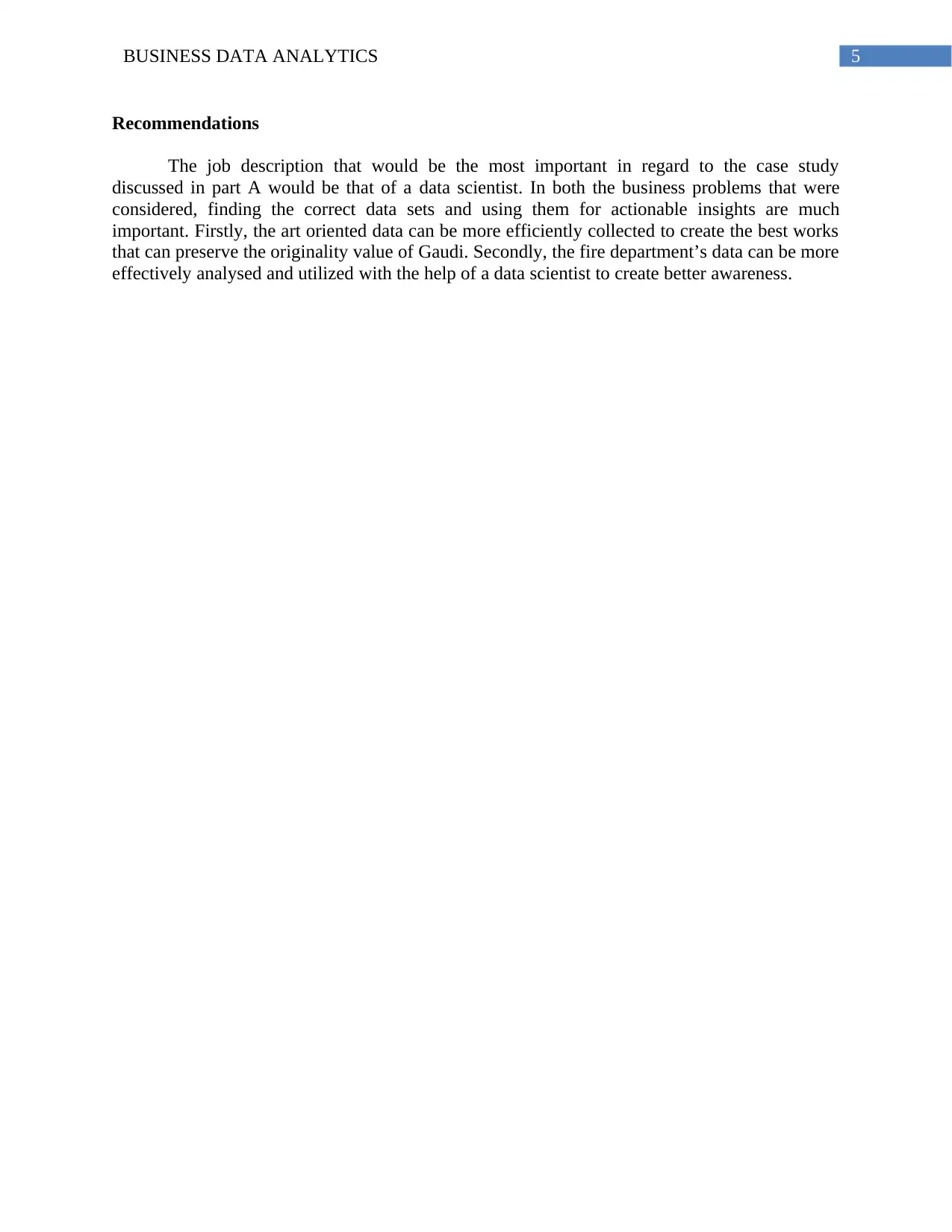
5BUSINESS DATA ANALYTICS
Recommendations
The job description that would be the most important in regard to the case study
discussed in part A would be that of a data scientist. In both the business problems that were
considered, finding the correct data sets and using them for actionable insights are much
important. Firstly, the art oriented data can be more efficiently collected to create the best works
that can preserve the originality value of Gaudi. Secondly, the fire department’s data can be more
effectively analysed and utilized with the help of a data scientist to create better awareness.
Recommendations
The job description that would be the most important in regard to the case study
discussed in part A would be that of a data scientist. In both the business problems that were
considered, finding the correct data sets and using them for actionable insights are much
important. Firstly, the art oriented data can be more efficiently collected to create the best works
that can preserve the originality value of Gaudi. Secondly, the fire department’s data can be more
effectively analysed and utilized with the help of a data scientist to create better awareness.
⊘ This is a preview!⊘
Do you want full access?
Subscribe today to unlock all pages.

Trusted by 1+ million students worldwide
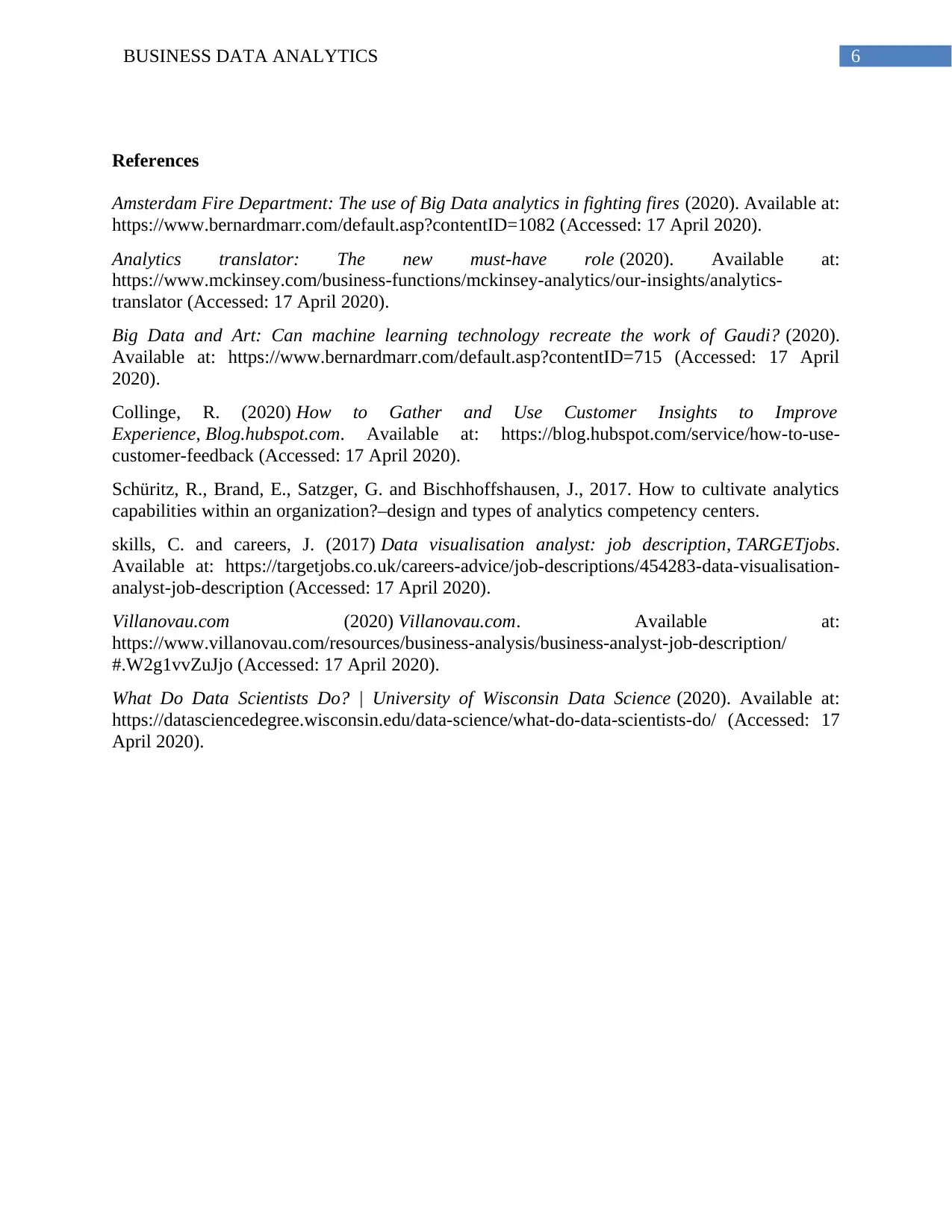
6BUSINESS DATA ANALYTICS
References
Amsterdam Fire Department: The use of Big Data analytics in fighting fires (2020). Available at:
https://www.bernardmarr.com/default.asp?contentID=1082 (Accessed: 17 April 2020).
Analytics translator: The new must-have role (2020). Available at:
https://www.mckinsey.com/business-functions/mckinsey-analytics/our-insights/analytics-
translator (Accessed: 17 April 2020).
Big Data and Art: Can machine learning technology recreate the work of Gaudi? (2020).
Available at: https://www.bernardmarr.com/default.asp?contentID=715 (Accessed: 17 April
2020).
Collinge, R. (2020) How to Gather and Use Customer Insights to Improve
Experience, Blog.hubspot.com. Available at: https://blog.hubspot.com/service/how-to-use-
customer-feedback (Accessed: 17 April 2020).
Schüritz, R., Brand, E., Satzger, G. and Bischhoffshausen, J., 2017. How to cultivate analytics
capabilities within an organization?–design and types of analytics competency centers.
skills, C. and careers, J. (2017) Data visualisation analyst: job description, TARGETjobs.
Available at: https://targetjobs.co.uk/careers-advice/job-descriptions/454283-data-visualisation-
analyst-job-description (Accessed: 17 April 2020).
Villanovau.com (2020) Villanovau.com. Available at:
https://www.villanovau.com/resources/business-analysis/business-analyst-job-description/
#.W2g1vvZuJjo (Accessed: 17 April 2020).
What Do Data Scientists Do? | University of Wisconsin Data Science (2020). Available at:
https://datasciencedegree.wisconsin.edu/data-science/what-do-data-scientists-do/ (Accessed: 17
April 2020).
References
Amsterdam Fire Department: The use of Big Data analytics in fighting fires (2020). Available at:
https://www.bernardmarr.com/default.asp?contentID=1082 (Accessed: 17 April 2020).
Analytics translator: The new must-have role (2020). Available at:
https://www.mckinsey.com/business-functions/mckinsey-analytics/our-insights/analytics-
translator (Accessed: 17 April 2020).
Big Data and Art: Can machine learning technology recreate the work of Gaudi? (2020).
Available at: https://www.bernardmarr.com/default.asp?contentID=715 (Accessed: 17 April
2020).
Collinge, R. (2020) How to Gather and Use Customer Insights to Improve
Experience, Blog.hubspot.com. Available at: https://blog.hubspot.com/service/how-to-use-
customer-feedback (Accessed: 17 April 2020).
Schüritz, R., Brand, E., Satzger, G. and Bischhoffshausen, J., 2017. How to cultivate analytics
capabilities within an organization?–design and types of analytics competency centers.
skills, C. and careers, J. (2017) Data visualisation analyst: job description, TARGETjobs.
Available at: https://targetjobs.co.uk/careers-advice/job-descriptions/454283-data-visualisation-
analyst-job-description (Accessed: 17 April 2020).
Villanovau.com (2020) Villanovau.com. Available at:
https://www.villanovau.com/resources/business-analysis/business-analyst-job-description/
#.W2g1vvZuJjo (Accessed: 17 April 2020).
What Do Data Scientists Do? | University of Wisconsin Data Science (2020). Available at:
https://datasciencedegree.wisconsin.edu/data-science/what-do-data-scientists-do/ (Accessed: 17
April 2020).
1 out of 7
Related Documents
Your All-in-One AI-Powered Toolkit for Academic Success.
+13062052269
info@desklib.com
Available 24*7 on WhatsApp / Email
![[object Object]](/_next/static/media/star-bottom.7253800d.svg)
Unlock your academic potential
Copyright © 2020–2025 A2Z Services. All Rights Reserved. Developed and managed by ZUCOL.





